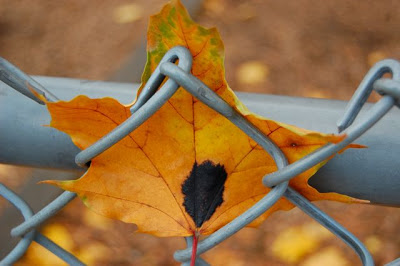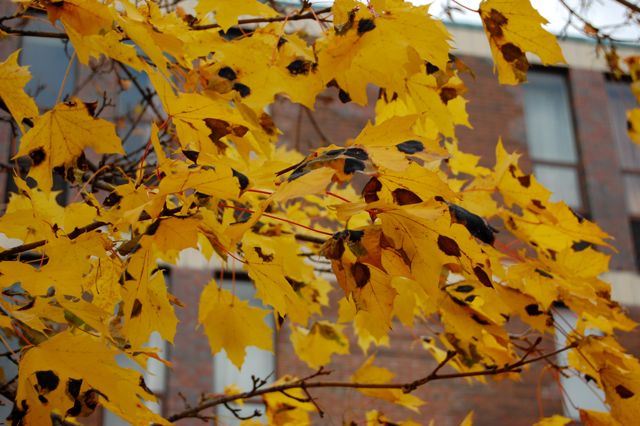Black tar spot of maples (Rhytisma acerinum) is one of the few excuses I can accept for sending your leaves off in the yard waste truck. Toronto gardeners have likely noticed this unsightly fungal disease over the past few years. It manifests as dime- or quarter-sized black spots on leaves, hitting many kinds of maple (Acer), including Norways (the sample above), red, silver and sugar. Tar spot isn’t a threat to the life of the tree, but it is not pretty to look at, especially now when the leaf colours change.
In theory, the only sensible treatment is to avoid letting infected fallen leaves remain in the garden, so that the spores can’t reproduce the following spring. That requires hot composting – which, for most of us, means bagging the leaves and putting them out for the compost pick-up. Municipal compost piles get hot enough to kill most of the fungal spores.
However, in areas where maples are heavily planted, such as the east end of the city where entire streets are shaded by Norway maples, bagging is probably a futile endeavor. There are just too many leaves, and they and their spores can hide everywhere. I still leave mine to provide humus to my sandy soil. Tar spot is thought to be a cyclical problem that will eventually run down.
 A healthy tree is the best defense against diseases that might otherwise weaken it through repeated early defoliation. Make sure your trees are watered during drought, and try not to damage the root system through reckless digging or damage the trunk by raising the soil level like this.
A healthy tree is the best defense against diseases that might otherwise weaken it through repeated early defoliation. Make sure your trees are watered during drought, and try not to damage the root system through reckless digging or damage the trunk by raising the soil level like this.
For more information, here are fact sheets from University of Guelph, the Ontario Ministry of Agriculture, Food and RuralAffairs (which is what OMAFRA stands for) and from Cornell University.





9 comments
I too have this but, lazily, haven't dealt with the front yard Norway leaves yet. Will the fungus hurt other plants in the garden if I go ahead and compost the leaves? (I pile my leaves in bins in the back, allowing them to rot away; come summer, albeit late summer, I have the most lovely wormy mulchy stuff.) Or should I just get rid of the fungus'd leaves from the front like everyone else does?
Rose
Rose, This fungus is specific to maple trees, so won't have any effect on your non-mapley plants.
If you can manage to collect every single leave in every single corner of your yard, and get all your neighbours to do the same thing, go ahead and bag them. Otherwise, go ahead and do as you've been doing.
Another method I've read is to literally bag them — in black plastic bags, with a bit of moisture — and hide them somewhere where they can decompose somewhat anaerobically.
Helen,
Thanks! I'm close to being out of bin room so I think I might try the black bag method. I've also read that it's good to scatter some compost in with the bagged leaves to speed the decay. I already do that with the binned leaves – I scatter a little layer of soil in every now and then. I figure it can't hurt and it introduces the worms to their appointed task that much more quickly. Whatever it does (or doesn't do), I have some mighty nice stuff in August!
Rose
Rose,
The idea of black-bagging these leaves is not to compost them, but to rot them. The difference is that they become a kind of sodden (often smelly) mess when finished, a process that does tend to kill things like weed seeds or fungal spores.
Once they've reduced to a black bog, you can add them to the compost pile to turn them into something sweet-smelling and lovely… through alternate layering of brown and green matter, as you suggest.
Good luck riding the spots out. I always hope the problems in my garden will go away if I just leave them alone for a while, but they usually don't. I hope the spots do cycle out for you, though.
Thanks for posting this, I was wondering what those ugly spots were!
Good advice! Why people over mulch the ground below their trees is puzzling. I've not seen the black tar on maples here…but we have all kinds of problems with our oaks, beetles eating our pines and that nasty adelgid killing the Southern hemlocks. It's tough out there right now! gail
What an informative post. We don't have that problem because we cannot grow those types of trees, but the information can be applied to many other types of fungal infections of plants, such as blackspot in roses.
Thanks for the info, Helen. I have this on our huge red maple – really thought it was part of the decomposition of the leaves in the autumn. Always have all the leaves raked up, but will be extra diligent this year.